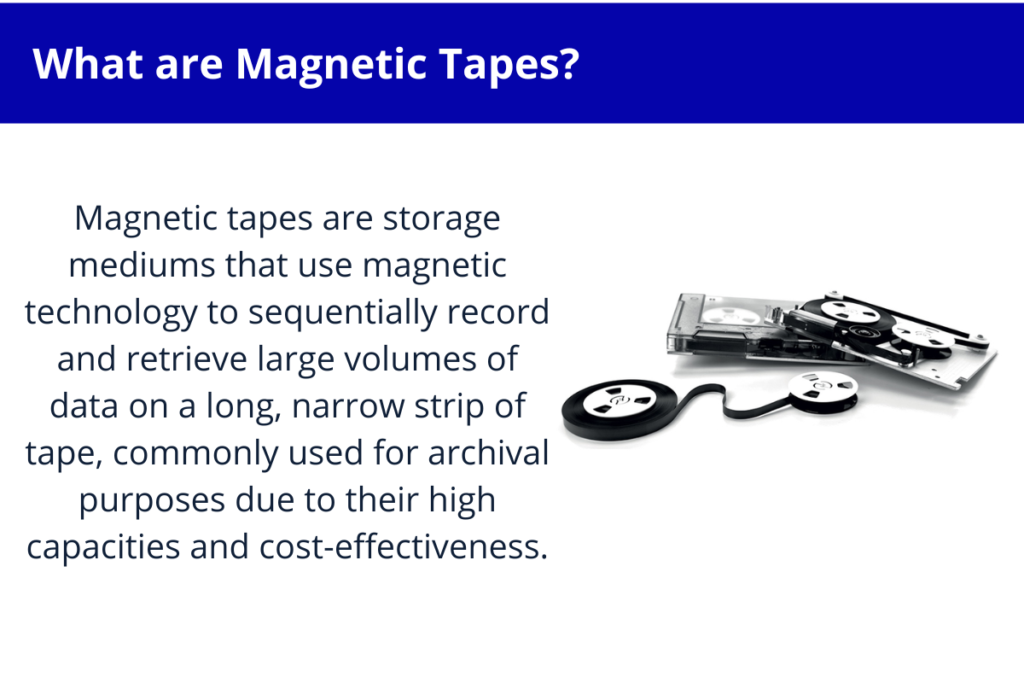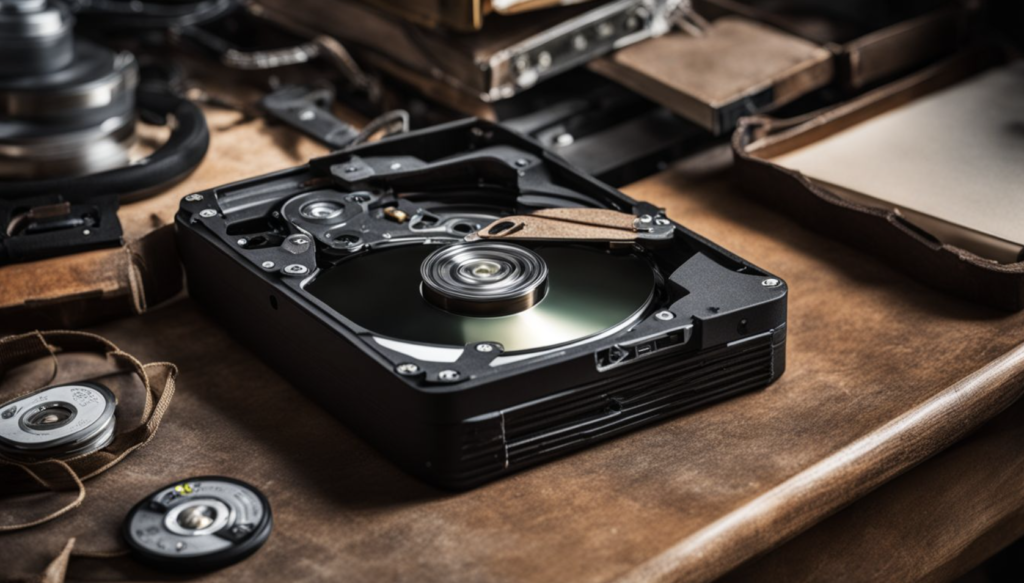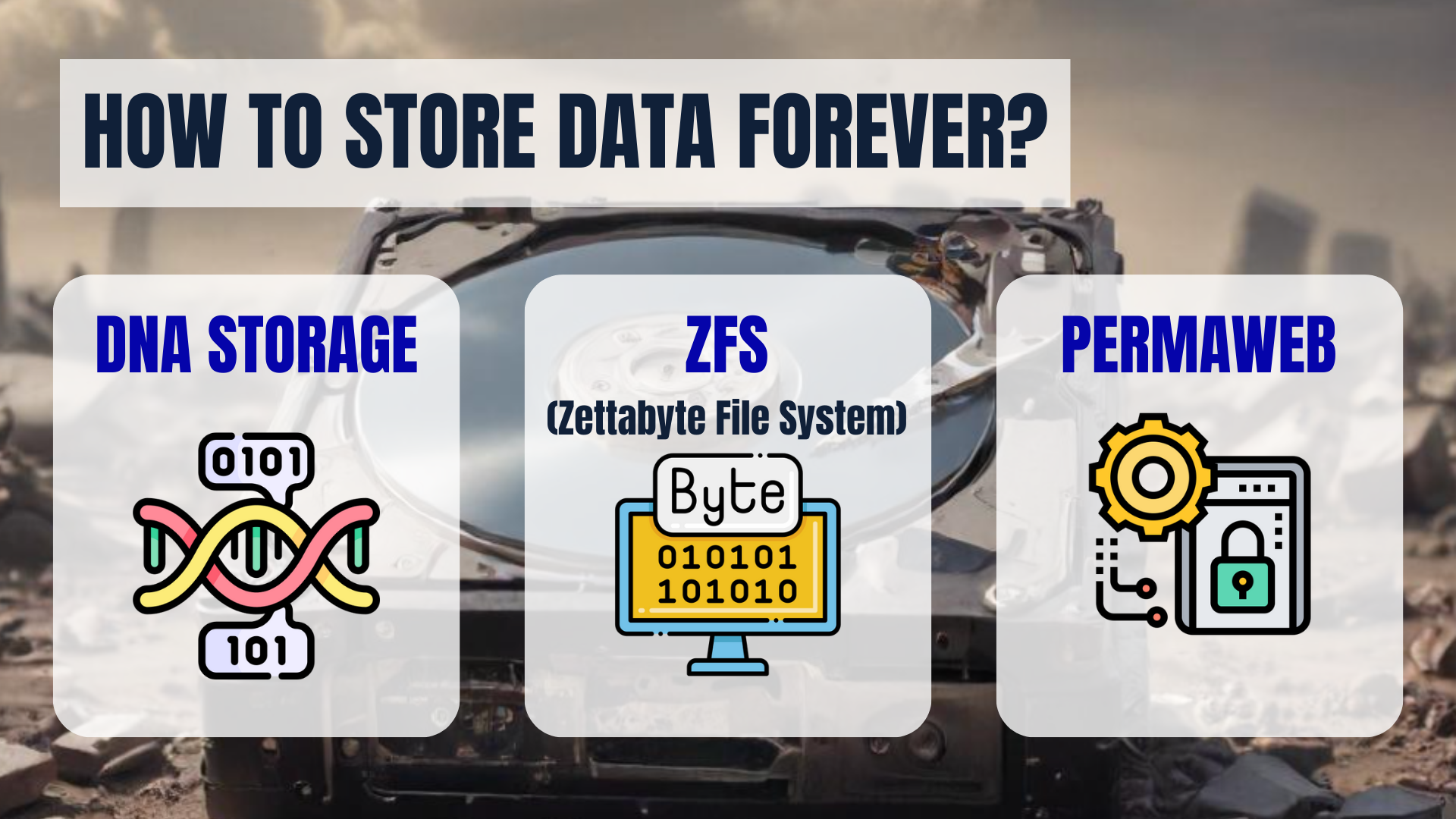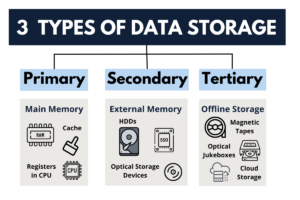Don you want to store data forever? Are you worried about losing your digital photos, important documents, and cherished memories?
Digital media like hard drives and solid-state drives can fail over time. This article will show you how to store data forever with the best long-term solutions.
Keep reading for secure storage tips to store data forever.
Table of Contents
Key Takeaways
- Save your data on archival-grade optical discs like M-DISCs because they can keep information safe for hundreds of years.
- Use magnetic tape solutions such as Ultrium LTO cartridges for storing important files; they can last 30-50 years.
- Solid-State Drives offer fast and reliable storage but only last about 5-10 years, so back up your data often.
- Consider innovative options like DNA storage in ice vaults or using blockchain to ensure data integrity for a long time.
- Keep your stored data safe with encryption techniques and by controlling who can access the information.

Challenges of Long-Term Data Storage
Keeping your files safe forever is tough. Files can wear out or become unreadable as technology changes, and formats we use today might not work tomorrow.
Data Degradation
Data degradation means that over time, the quality or usability of stored data gets worse because of wear and tear on storage devices, bad conditions like heat or moisture, or outdated formats and technology.
Your digital stuff, like photos and files on hard drives and SSDs, won’t last forever because they break down over time. Hard drives usually work well for about 3-5 years, while SSDs can go a bit longer—around 5-10 years.
But to keep your info safe, you need to back it up and sometimes get new storage.
Even the best technology has an expiration date.
Technological Obsolescence
Technology moves fast, and what’s new today becomes old tomorrow. This means your data storage devices might not work with future computers. Think floppy disks; they were once everywhere, and now few devices can read them.
The same could happen to USB flash drives and hard disk drives you rely on today. Cloud storage seems safe but think again—companies close or change services, leaving you without access.
File Format Obsolescence
File formats also change. What works today might not open tomorrow. Imagine saving all your photos in a format that no one can access in 10 years. Scary, right? This is file format obsolescence.
It happens because software evolves and old types of files become unreadable with new programs. To fight this, use formats widely accepted and less likely to become outdated, like PDFs for documents or JPEGs for images.
In my experience, I know people that still use MacDraw files in their professional life. These files can’t be opened with anything else, so they need to keep computer or two just for that. You wouldn’t like that to happen with your files, right?
Next, focus on digital storage media that stand the test of time…
Best Long-Term Digital Storage Media to Store Data Forever
Picking the right place to store data forever matters. I am talking about things like archival-grade DVDs, strong magnets that store data, and drives without moving parts. These are my top picks.
Archival-grade Optical Discs
Archival-grade optical discs, like M-DISCs, stand out for their long-lasting nature.
Archival-grade optical discs are specially manufactured discs, such as CDs, DVDs, or Blu-rays, designed for long-term data storage.
They are made with higher-quality materials and a special data layer to ensure your data longevity and integrity over many years. They often claim to have lifespans of up to 100 years or more under the proper storage conditions.
Unlike regular CDs and DVDs that might fail over time due to degradation, these Blu-ray discs can resist such damage. They’re built tough to withstand the test of time.
When you store your data on these discs they stay intact—resistant to heat, light, and moisture. It’s a solid choice to ensure that what matters most to you doesn’t disappear into thin air because of material breakdown or environmental factors.
Magnetic Storage Solutions
Magnetic tape solutions, like Ultrium LTO cartridges, offer you a strong option for long-term data storage. They can keep your data safe for 30-50 years in the right conditions. These tapes are built tough; they handle over a million passes and promise to last up to half a century.
And you get peace of mind knowing your important files stay intact over decades with minimal risk of degradation or loss.
Choosing magnetic tapes means betting on reliability and longevity. Cold storage environments are perfect for these tapes, slowing down any deterioration and keeping your data as good as new for generations.
It’s a smart move if you’re looking into secure backups or archiving key information without worrying about constant updates or tech obsolescence.

Solid-State Drives
Solid-State Drives (SSDs) are your go-to for speed and reliability in storing data. Unlike hard disks, SSDs have no moving parts, making them less likely to fail. They work faster, booting systems and opening files in a snap.
But they come with a catch—they last only 5-10 years. To keep your data safe, you need to back it up regularly and plan for replacements.
For long-term archiving, think of SSDs as sprinters, not marathon runners. Use them alongside other storage methods like external hard drives or cloud services. This way, you safeguard your data against loss from drive failures or technology updates.
Remember to migrate important files from older SSDs before their lifespan ends, ensuring access to your digital memories or critical records without interruption.

Innovative Storage Solutions to Store Data Forever
Innovative storage options are changing the game of data storage and they will help you store data forever. I am thinking about DNA data in ice vaults, blockchain for keeping data safe, and zettabyte systems for holding lots of info. Curious? Just keep reading to discover more about these cool solutions to store data forever.
Encapsulated DNA in Ice Vaults
DNA storage is a new method to preserve your digital information by encoding it into DNA molecules and storing them in frozen environments, like ice, for long-term storage.
The data is encoded into DNA nucleotide bases (adenine (A), thymine (T), guanine (G) and cytosine (C)) to be later read. Scientists store your data in DNA strands, placing them inside ice vaults. This method keeps the information safe for hundreds of years. Cold and dry conditions stop the DNA from breaking down.
Think of it like a high-tech time capsule.
DNA is where your future memories rest.
DNA storage can also store large amounts of data. A tiny ball can hold 33 zettabytes of data—that’s a ton! But, making this happen isn’t cheap yet. It costs thousands to save just a bit of info this way. Still, as prices drop, more people will use DNA to keep their digital treasures safe for ages.
If you want to learn how to store large amounts of data, you should definitely check our guide . I think it will help you a lot :).
I personally think DNA storage cloud be the future of data storage.
Blockchain for Data Integrity
Blockchain technology ensures your data stays safe and unchanged. It works like a digital ledger, where every piece of information gets its own secure block. These blocks link together in a chain, making it tough for anyone to change past data without notice.
This setup is ideal to keep records that must not be altered, such as legal documents or property rights.
Experts use blockchain networks to keep data secure over long periods. Bitcoin’s blockchain is one of the most famous examples. It shows how effective this method can be. With blockchain, you’re looking at a future where your important information can remain intact and trustworthy for years.
This tech also opens doors to new ways of storing large amounts of data securely, like the Zettabyte File System for massive-scale storage projects.
Zettabyte File System for Large Scale Storage
Zettabyte File System (ZFS) is a type of computer file system designed to handle large amounts of data efficiently and reliably.
Think big, like storing all the photos you’ve ever taken or every book you’ve ever read. This system can hold a lot of information without breaking a sweat.
It keeps copies of your data so if one part gets lost or damaged, there’s always a backup ready.
With ZFS, checking on your data’s health is really easy. It scans for bad spots and fixes them before they cause trouble. Plus, it can grow with your needs – add more storage space anytime without starting from scratch.
Big companies and tech-savvy folks love using ZFS for these reasons. It keeps their massive amounts of information organized and reachable 24/7.
Data Preservation Strategies
When you need to store data forever, keeping your data safe over time needs smart planning. Think about using RAID for extra protection and moving your data to new storage spots regularly to avoid loss.
Redundant Array of Independent Disks (RAID)
RAID keeps your data safe by using multiple hard drives. It’s like making copies of your important photos, but for all the files on your computer. If one disk fails, you won’t lose anything because the same information is stored on another disk.
This setup not only protects your data but can also make accessing it faster.
For example, RAID1 mirrors your data across two disks. Imagine having two keys to the same lock; if one gets lost, you still have a way in. Other types, like RAID5, use something called parity.
This means they spread out the data and add special info that helps rebuild any lost bits if a drive goes bad. With these tactics, RAID ensures no single drive failure will wipe out your precious information.

Regular Data Migration
Moving your data regularly ensures it stays accessible and safe. Think of it as updating your wardrobe; just as styles change, so does technology. By transferring files from old storage devices to new ones, you avoid losing them due to hardware failure or outdated formats.
For example, just by copying data from an aging hard drive to a solid-state drive (SSD) every few years you could keep the information current and retrievable for when you need it.
Regular data migration is like giving your digital life a consistent upgrade.
This process also protects you against malware attacks. Malware often targets older systems with known weaknesses. But when you move your data to a newer systems with better security features you could mitigate these risks. Again, it is better to use software RAID setups for smoother transitions between drives without losing information integrity during migrations.
Cloning tools can help too, making exact copies of your data on different media—like moving songs from CDs to USBs—and ensuring nothing gets lost in translation.
By keeping up with regular migrations—let’s say, every five years—you make sure that no matter what comes next in technology advancements or challenges like electronic decay or format changes, you’re ahead of the game.
Use of Permaweb for Persistent Storage
Permaweb ensures your data stays safe forever. This tool uses blockchain to keep every bit of your information permanent and tamper-proof. Just imagine posting something online and knowing it will be there for generations.
That’s what Permaweb does. It’s like a digital storage locker that never rusts, breaks, or gets lost.
You can store texts, pictures, important records—anything digital—on Permaweb with confidence. Its technology is smart and strong because it spreads out data across many computers around the world.
This way, even if one computer has problems, your data is still safe on others. So go ahead, save those precious family photos or back up important documents without worry.
Next up: How keeping your data safe requires not just good storage but also strict security measures.

Security Measures for Long-Term Storage
To keep your data safe for a long time, you should use secret codes and rules on who can see it your data. Tools like encryption software and access control systems play big roles in this job.
In my experience, they are really important to safeguard your personal information and avoid intrusive eyes.
Encryption Techniques
Encryption keeps your data safe. It changes info into a secret code. You need a key to read it. This is like a lock on your data, only letting the right people see it. Magnetic tapes and Ultrium LTO tape cartridges use encryption for extra security.
They can last 50 years or more.
DNA storage also uses encryption. Scientists take information and store it in DNA sequences. Even though this sounds like science fiction, it’s real and very secure. Your data could be kept safe for thousands of years with this method.
When choosing a service to store data forever, it is better to opt for end-to-end encryption. This way you make sure that not even the provider can access your information.
For more safety, you can even choose two-key assymetric encryption.

Data Access Controls
Safe data storage permanently means strict rules on who can see or change the information.
For DNA and optical media like CDs, these rules can stop unwanted eyes and keep data exact.
As such, you need strong controls to fight off risks like wrong DNA reads or messing with files. As storing info in DNA gets easier, tight access rules are key for keeping your private details safe.
These access rules use things like strong passwords and encryption to lock data away from hackers. Only certain people can get in, based on their need to know. This stops bad guys from getting into places they shouldn’t be and keeps your information safe for years.
For more safety, you can even choose two-key assymetric encryption.

Just another tip, if you use cloud storage to secure your personal data, you should check our guide on how to protect your cloud storage security.
Conclusion
If you want to Store Data Forever and keep memories and records safe, choose archival-grade discs, magnetic storage, or solid-state drives for long-lasting solution. For cutting-edge and more durable options, think about DNA in ice vaults, blockchain tech or permaware.
Make copies with RAID and migrate data regularly to stay current. Secure everything with encryption and control who sees what. This way, you ensure your digital treasures last a lifetime – and beyond.
FAQs – How to Store Data Forever?
1. What’s the best way to back up your data for a long time?
Use multiple storage mediums like SSD drives, LTO Ultrium tape cartridges, and cloud services. Combine data redundancy techniques such as mirroring and RAID arrays to ensure data durability.
2. How do you prevent data loss from hard drive failure?
Regularly check your drives with S.M.A.R.T technology to spot bad sectors early. Also, use non-volatile memory options like flash memory for important files.
3. Can optical storage last forever?
No, but CD/DVD drives offer a durable option for decades if stored properly—away from direct sunlight and in a cool, dry place.
4. Is there an innovative method for storing digital data long-term?
Yes, DNA data storage is emerging as a future solution. It encodes digital information into the genetic sequence of DNA molecules, promising high density and millennia-long stability.
5. Why is maintenance important in long-term data storage?
Maintenance ensures that technological innovations keep your storage systems up-to-date and running smoothly—preventing failures that could lead to irreversible data loss.
6. How can I protect my stored data from security threats?
Focus on robust encryption methods and regular updates to safeguard against viruses and hackers. Employing endowment strategies like blockchain can add another layer of security by distributing copies across multiple locations.





